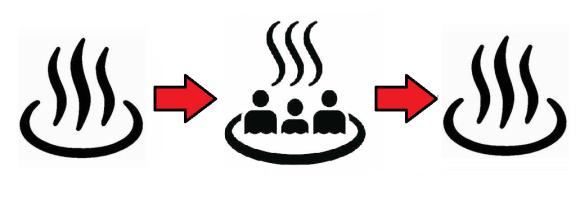
Two prefectures, both famous for their onsen, are particularly opposed to the switch.
Japan is extremely excited about hosting the 2020 Olympics. Since the Games were awarded to Tokyo three years ago, hardly a week goes by without an announcement or report about how some organization is getting ready for the influx of foreign visitors that will be coming to the capital to watch the world’s finest athletes compete.
Among the measures being considered are reforms regarding the iconography used on Japanese maps, signs, and tourist literature. In January, the government began looking into replacing the traditional symbol for Buddhist temples to avoid confusion with the Nazi swastika, and in July, it unveiled a new symbol to be used to designate the nation’s numerous hot springs, or onsen, as they’re called in Japanese.
The currently used symbol consists of three pillars of steam rising out of a pool of naturally heated water. However, the Japanese Industrial Standards Committee, part of the government’s Ministry of Economy, Trade, and Industry, worries that this could be misconstrued as indicating a restaurant that serves hot food, and so created a replacement that adds a trio of bathers to the design.
On December 6, the Industrial Standards Committee released the results of a poll in which 70 percent of surveyed foreigners said they found it easy to grasp the meaning of the new symbol. However, the same study also showed that 60 percent of the Japanese residents who were asked for their opinion are against abolishing the old onsen symbol.
Opposition to the change is particularly strong in Gunma and Oita. Both prefectures draw large numbers of tourists to their popular hot spring resorts, and both also claim to be the birthplace of the current people-free onsen symbol. Yasuhiro Nagano, the mayor of Oita’s town of Beppu (who’s been making headlines recently for his plan to build an onsen theme park in his constituency), went so far as to assert that the current onsen symbol is a part of the town’s traditional culture, and added that “As a citizen of Beppu, I have concerns about the symbol being discontinued so quickly.”
Hospitality providers have also voiced concerns about doing away with the current symbol, which is heavily featured in graphic designs used for rail stations, sightseeing maps, and souvenirs in hot spring communities. In light of the unexpectedly strong opposition, the Industrial Standards Committee has announced that it is rethinking its position as it weights the pros and cons of keeping the onsen symbol as it is, and that it will make its final decision in March of next year.
Source: NHK News Web via Hachima Kiko
Top image: pbs.twimg.com/Open Clip Art/Negaskun (edited by RocketNews24)
Follow Casey on Twitter, where’d he be perfectly happy to spend the next three months soaking in hot water.

 Japan’s most famous hot spring resort runs ad telling us to go to…a different hot spring resort
Japan’s most famous hot spring resort runs ad telling us to go to…a different hot spring resort Japanese government recommends changing Buddhist temple mark on maps to avoid Nazi connotations
Japanese government recommends changing Buddhist temple mark on maps to avoid Nazi connotations Japanese mayor responds to public after “spamusement park” onsen video reaches 1 million views
Japanese mayor responds to public after “spamusement park” onsen video reaches 1 million views Famous hot springs of Beppu now offering portable inflatable onsen with authentic Beppu water
Famous hot springs of Beppu now offering portable inflatable onsen with authentic Beppu water Free onsen! Kyushu resort shipping hot spring water to homes across Japan in thank-you program
Free onsen! Kyushu resort shipping hot spring water to homes across Japan in thank-you program This downtown Tokyo cafe is like a time machine that takes you back 50 years into the past
This downtown Tokyo cafe is like a time machine that takes you back 50 years into the past Station of despair: What to do if you get stuck at the end of Tokyo’s Chuo Rapid Line
Station of despair: What to do if you get stuck at the end of Tokyo’s Chuo Rapid Line Japanese government will check and judge new baby name pronunciations, presents guidelines
Japanese government will check and judge new baby name pronunciations, presents guidelines Totoro towels gently glow in the dark to set the Ghibli nighttime mood in your home【Photos】
Totoro towels gently glow in the dark to set the Ghibli nighttime mood in your home【Photos】 The best Christmas Market in Japan? Yokohama event is top choice for travellers
The best Christmas Market in Japan? Yokohama event is top choice for travellers Shakey’s is back! All-you-can-eat pizza chain returns to downtown Tokyo’s Shinjuku
Shakey’s is back! All-you-can-eat pizza chain returns to downtown Tokyo’s Shinjuku Starbucks Japan releases a new Frappuccino that looks and tastes like a floral bouquet
Starbucks Japan releases a new Frappuccino that looks and tastes like a floral bouquet Evangelion and McDonald’s Japan launch first-ever collaboration with transforming figures【Video】
Evangelion and McDonald’s Japan launch first-ever collaboration with transforming figures【Video】 Japanese company develops classy heavy metal band frames for glasses
Japanese company develops classy heavy metal band frames for glasses We put the internet’s “techniques for emptying your bladder with morning wood” to the test
We put the internet’s “techniques for emptying your bladder with morning wood” to the test One of Japan’s rarest sweets is a sell-out hit that looks and tastes like frost
One of Japan’s rarest sweets is a sell-out hit that looks and tastes like frost Studio Ghibli showcases traditional craftsmanship with new wallet range
Studio Ghibli showcases traditional craftsmanship with new wallet range Mysterious light-up rainy night-sound Totoro figure doesn’t actually show a scene from the anime
Mysterious light-up rainy night-sound Totoro figure doesn’t actually show a scene from the anime Major Japanese city is abolishing extracurricular activities at all of its middle schools
Major Japanese city is abolishing extracurricular activities at all of its middle schools Over 800 Studio Ghibli anime world paintings compiled in beautiful new hardcover art book【Pics】
Over 800 Studio Ghibli anime world paintings compiled in beautiful new hardcover art book【Pics】 Spirited Away and Princess Mononoke plushies show a softer side of formidable Ghibli characters
Spirited Away and Princess Mononoke plushies show a softer side of formidable Ghibli characters Studio Ghibli tea blends contain ingredients inspired by My Neighbour Totoro
Studio Ghibli tea blends contain ingredients inspired by My Neighbour Totoro Possessing Harry Potter’s Sword of Godric Gryffindor is now illegal in Japan
Possessing Harry Potter’s Sword of Godric Gryffindor is now illegal in Japan Uniqlo announces first-ever collaboration with horror manga master Junji Ito【Photos】
Uniqlo announces first-ever collaboration with horror manga master Junji Ito【Photos】 J-pop mega star Ado reveals she’s been living in the U.S., may not understand language acquisition
J-pop mega star Ado reveals she’s been living in the U.S., may not understand language acquisition Starbucks Japan is calling it quits with paper straws
Starbucks Japan is calling it quits with paper straws Studio Ghibli releases new range of cardigans for anime fans
Studio Ghibli releases new range of cardigans for anime fans Japan’s most popular castle raising ticket prices by up to 200 percent for non-local tourists
Japan’s most popular castle raising ticket prices by up to 200 percent for non-local tourists Furikake rice seasoning sales are soaring, which is bad news for Japan as a whole
Furikake rice seasoning sales are soaring, which is bad news for Japan as a whole Studio Ghibli heroine cardigans give you warmth and strength to face everyday challenges
Studio Ghibli heroine cardigans give you warmth and strength to face everyday challenges Eight unforgettable hot springs, as recommended by Japan’s “Professor Bath”
Eight unforgettable hot springs, as recommended by Japan’s “Professor Bath” McDonald’s new Happy Meals offer up cute and practical Sanrio lifestyle goods
McDonald’s new Happy Meals offer up cute and practical Sanrio lifestyle goods Foreign tourists on Shinkansen bullet train break suitcase etiquette, angering local passengers
Foreign tourists on Shinkansen bullet train break suitcase etiquette, angering local passengers [Deleted] Article written for April Fool’s Day 2018
[Deleted] Article written for April Fool’s Day 2018 Japanese government to make first change to romanization spelling rules since the 1950s
Japanese government to make first change to romanization spelling rules since the 1950s Foreigner’s request for help in Tokyo makes us sad for the state of society
Foreigner’s request for help in Tokyo makes us sad for the state of society Japanese convenience store Family Mart announces abolishment of eat-in spaces
Japanese convenience store Family Mart announces abolishment of eat-in spaces Life-size vibrating Legend of Zelda Master Sword for sale from Nintendo【Photos】
Life-size vibrating Legend of Zelda Master Sword for sale from Nintendo【Photos】 Princesses, fruits, and blacksmiths: Study reveals the 30 most unusual family names in Japan
Princesses, fruits, and blacksmiths: Study reveals the 30 most unusual family names in Japan Studio Ghibli releases free-download board game — Here’s how to play it without reading Japanese
Studio Ghibli releases free-download board game — Here’s how to play it without reading Japanese Hyotan Onsen – Japan’s only hot spring with three Michelin stars
Hyotan Onsen – Japan’s only hot spring with three Michelin stars New onsen facility in the heart of Tokyo’s business district to be ready for Olympics
New onsen facility in the heart of Tokyo’s business district to be ready for Olympics Japan’s hot spring amusement park has opening date, wants 100 million yen in crowdfunding money
Japan’s hot spring amusement park has opening date, wants 100 million yen in crowdfunding money Learn all about enjoying a traditional Japanese-style ryokan inn from this nine-minute video!
Learn all about enjoying a traditional Japanese-style ryokan inn from this nine-minute video! Eight unforgettable hot springs, as recommended by Japan’s “Professor Bath”
Eight unforgettable hot springs, as recommended by Japan’s “Professor Bath” You can make your own hot spring bath at this river in central Japan【Japan travel】
You can make your own hot spring bath at this river in central Japan【Japan travel】 Japan’s onsen amusement park begins crowdfunding campaign with awesome returns for investors
Japan’s onsen amusement park begins crowdfunding campaign with awesome returns for investors Secret hot spring onsen in Japan is a hidden gem waiting to be discovered by tourists
Secret hot spring onsen in Japan is a hidden gem waiting to be discovered by tourists Onsen in Japan uses the same mysterious hot spring bathing system from Ghibli film Spirited Away
Onsen in Japan uses the same mysterious hot spring bathing system from Ghibli film Spirited Away Oita lures travelers with wonderful montage of synchronized hot spring bathing 【Video】
Oita lures travelers with wonderful montage of synchronized hot spring bathing 【Video】 Iconic Kyoto Tower bathhouse closes due to coronavirus
Iconic Kyoto Tower bathhouse closes due to coronavirus This gorgeous hot spring is actually part of one of Japan’s most convenient airports【Photos】
This gorgeous hot spring is actually part of one of Japan’s most convenient airports【Photos】 Japanese government encouraging hot springs to ease tattoo restrictions
Japanese government encouraging hot springs to ease tattoo restrictions Got tattoos, but still want to experience a Japanese hot spring? It’s no problem here!
Got tattoos, but still want to experience a Japanese hot spring? It’s no problem here! Hot spring in Gunma Prefecture found to reduce COVID-19 infectivity by over 90 percent
Hot spring in Gunma Prefecture found to reduce COVID-19 infectivity by over 90 percent
Leave a Reply